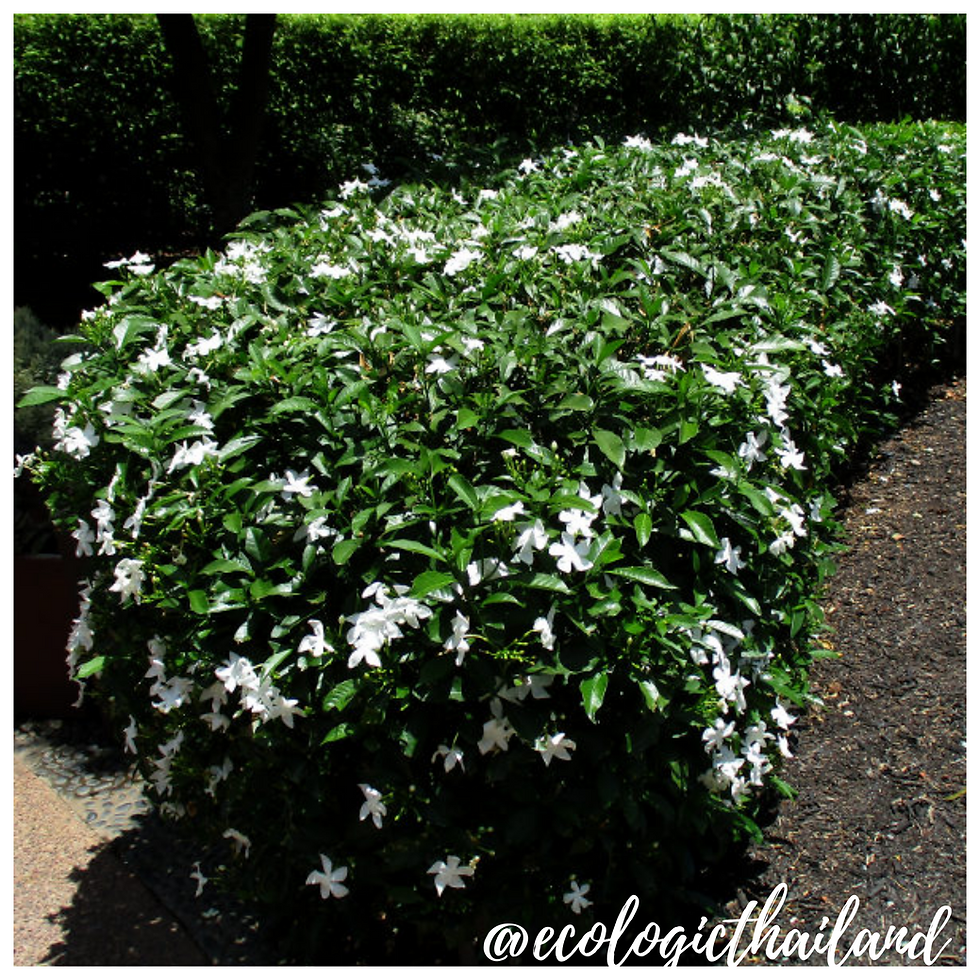Galangal
- Eco-Logic Resort
- Sep 30, 2020
- 3 min read
Updated: Nov 30, 2020
Kà: /ข่า | Alpinia galanga
Family: Zingiberaceae - Genus: Alpinia

Galangal can be found near the entrance of Mount Never-rest and close to the kitchen of Eco-Logic Thailand.
Galangal is herbaceous plant that belongs to the ginger family. Greater galangal, also known as Thai galangal is used as an ingredient in the Thai cuisine. Besides food, galangal is often used in folk medicine.
Once the galagal plant has blossomed, the roots are mature enough for harvesting, usually in about 10-12 months from sprouting.

THE PLANT
The plant grows from rhizomes in clumps of stiff stalks up to 2 meters in height with abundant long leaves that bear red fruit. Galangal develops long, narrow, blade-shaped green leaves.
Fruit of galangal is fleshy red capsule filled with seed.
Galangal is perennial plant (it can survive more than 2 years in the wild).

THE LEAVES
Galangal develops long, narrow, blade-shaped green leaves.
Galangal leaves are edible, fibrous and pungent when raw but become tender, sweet, and aromatic when cooked. The flavor of the leaves is similar to ginger, with a subtle spice and hints of citrus.

THE FLOWERS
Galangal blooms during the late summer and autumn. Flowers develop on top of the flowering stem. They are white colored and orchid-shaped. Flowers emit sweet aroma which attracts insects.
The flowers and tender shoots are used as a spice or vegetable.

THE ROOT
Galangal has fibrous, firm, knobby root that resembles the root of ginger. It has rough, sandy skin on the surface and ivory-yellowish flesh below.
CULINARY USES OF GALANGAL
The edible part of galangal are the roots (rhizome). It is used for the preparation of broths, soups, seafood salads and dishes made of meat. It can be used fresh (finely chopped) or dried (in the form of powder). Galangal is an integral part of Thai, cuisine. The most famous dish in Thailand, made with galangal, is Tom Kah. Click on the link of the Food Forest Kitchen for the recipe.
Galangal has sweet, earthy, spicy, mustard-like aroma. It smells like a blend of pine needles and black pepper. Galangal is often combined with lemongrass. Even though galangal and ginger share similarities in the shape, color and size, they have completely different taste. That's why galangal and ginger cannot replace each other in the recipes.
The leaves of galangal are also edible.
NUTRITION
Galangal plants contain iron, fiber, vitamin C, and vitamin A.
TRADITIONAL MEDICINAL USE OF THE GALANGAL PLANT
NOTE: please take advice from a doctor if you are planning to use herbal medicine.
Galangal can be used in treatment of nausea, constipation, flatulence, cramps and for detoxification of the body. Galangal oil can be used in treatment of bruises and swelling of the skin, while snuff (powder made of root) can be effective in treatment of respiratory disorders. Compounds isolated from galangal have anti-bacterial and mild anti-malarial properties. Tonic made of galangal, tamarind water and salt can be used for the purification of blood and for the normalization of the function of bowel in women after childbirth.
INTO THE WILD: a down to earth experience

For guests and visitors to Paksong we organize weekly tours "The Edible Forest" and Foraging weekends: Into the Wild. We work with local guides to take you in the jungle of Paksong. After foraging, we will cook a meal with the ingredients, using bamboo together with you!
Come and join and learn about the abundance of food that nature gives us!
INTO THE WILD!


















Comments